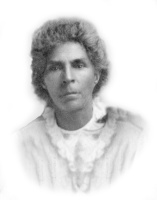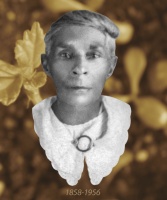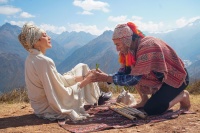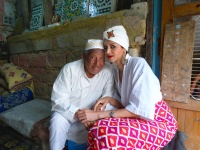Newsroom@BlackPRWire.com
877-BLACKPR



By Regina Lynch-Hudson/Special to Black PR Wire
(Black PR Wire) As headlines warn of deepening fault lines in America’s healthcare infrastructure, National Women’s Health Week (May 12–18) calls us to recognize the impactful force of women who have long stood in the breach—the caretakers, birth workers, herbalists, and healers who are central to the health of their communities.
Among them was my great-great-grandmother, Mary Louisa Stepp Burnette Hayden (1858–1956), whose life work in the Appalachian South exemplified the overlooked genius of women-led wellness.
A skilled healer, caregiver, herbalist, and midwife, Hayden embodied the ethos of prevention—a principle increasingly sidelined in modern medicine. Her legacy provides valuable insight into how traditional, community-based healing can inform the future of healthcare in America.
Born into slavery before the Civil War, Hayden worked in the Appalachian Mountains east of Asheville, NC, now the Swannanoa Valley. Her extensive mastery of medicinal plants and holistic wellness was rooted in ancestral wisdom passed down through generations. When midwifery became increasingly regulated in the 1920s, she was among the first African American women recognized by the Buncombe County Health Department as a licensed midwife.
Far more than a figure of historical intrigue, Hayden’s approach offers timely alternatives in a world where millions of American women face mounting barriers to healthcare. Her model of care serves as a blueprint for reaching underserved communities, particularly as we navigate healthcare access challenges in the 21st century.
From Hearth to Hospitals
As Americans migrated from rural homes to urban centers in the mid-20th century, community healers became relics of a bygone era, replaced by corporate medical systems focused on treatment rather than prevention. Currently, with regions across the U.S. facing hospital closures, provider shortages, and rising barriers to care, revisiting the preventative methods of healers like Hayden offers solutions to some of our most urgent healthcare challenges.
According to the Cecil G. Sheps Center for Health Services Research at the University of North Carolina, 198 rural hospitals ceased operations in the U.S. between 2005 and 2023.
The Power of Prevention: A Lost Priority
Hayden’s emphasis on prevention was her most significant contribution—one that became overshadowed as modern medicine prioritized the treatment of symptoms and diseases after their emergence. Unlike today's reactive healthcare model, practitioners like my great-great grandmother focused on maintaining health before illness manifested.
She educated families on how to incorporate medicinal plants into their daily diets, detect early signs of imbalance, and make lifestyle adjustments.
Her tonics, tinctures, and teas—often made from roots like echinacea, burdock, and dandelion—fortified immune systems through unforgiving Appalachian winters. Regular use of native botanicals kept communities resilient─ protocols now supported by nutritional science and reflected in the projected $229 billion growth of the global natural health industry by 2033.
Global Evidence of Traditional Healing Success
The effectiveness of traditional medicine and community-based healing systems isn’t mere speculation. My journeys have taken me to the Andean mountains of Peru, where I observed indigenous healers preparing remedies from plants that grow at high elevations, to Fez, Morocco, where I met with a medicine man who was part of a nomad caravan preserving centuries-old curative customs, to the rainforests of Belize, where Meshach, a native Tanzanian herbalist and naturalist guide led me through medicinal trails on a 400-acre property to identify hundreds of plants, trees, fruits, and vines traditionally used for medicinal purposes. This trek led to an unexpected connection between Appalachian and African healing legacies when Meshach, noticing the pendant I wore depicting my great-great-grandmother, remarked that her image reminded him of his forebears who bequeathed sacred skills spanning continents.
Sojourns included Egyptian markets, where traditional medicine practitioners preserved knowledge from pharaonic times, and Ayurvedic clinics in India, where I witnessed treatment protocols refined over thousands of years. These experiences demonstrate the continued value of herbal medicine and grassroots care models across diverse cultures worldwide.
According to the World Health Organization (WHO), traditional medicine remains the primary healthcare system for approximately 80% of the world’s population. Such practices have documented success, in managing conditions from digestive disorders to immune support. In much of the world, community healers maintain robust health outcomes despite limited access to modern medical facilities.
Healing Without Barriers
One of the most defining aspects of Hayden’s practice was her accessibility. Unlike today’s healthcare maze—often obstructed by bureaucracy and cost—she welcomed all, accepting food, handmade goods, or future favors instead of payment. No one was turned away. Her manner of practicing medicine affirmed care as a human right, not a privilege shaped by wealth, race, gender, or status.
Holistic vs. Pharmaceutical Solutions
The medicine woman’s approach was inherently holistic, treating the whole person rather than isolated symptoms. In contrast, today’s medicine is increasingly compartmentalized, and patients might see different specialists for various body systems with little coordination or communication between them.
Traditional practitioners typically spent extended time with their patients, routinely staying with families through difficult births or serious illnesses. They knew their patients as individuals and community members, not as medical record numbers.
Hayden’s reliance on concoctions made from local plants like goldenseal and ginseng was a far cry from the synthetic, experimental pharmaceuticals developed in laboratories and manufactured by large corporations. While modern drugs have saved countless lives, dependence on costly, often side-effect-prone medications contrasts with Hayden’s practical, plant-based treatments, which she gathered and prepared herself.
The Need for Modern “Granny Healers” to Address the Healthcare Crisis
As the United States faces the threat of reduced Medicaid coverage and institutional services grow more elusive, the role of localized caretakers—once called “granny healers”—gains renewed urgency.
Though we cannot entirely return to folk-era modalities, local networks must develop new versions of the lay-clinic practitioner’s role—trusted regional resources with practical aptitudes for preemptive wellness and fundamental Good Samaritanship.
This doesn’t mean rejecting contemporary medicine’s advances; we must supplement an increasingly inaccessible system with locally anchored insight and attentiveness. Present-day herbalists, village-based aides, and reparative circles of compassionate citizens might become essential safety nets if government-provided affordable care is unavailable to significant populations.
The current political climate makes this a necessity, not a romantic notion. As institutional doors close, civic windows must open. My foremother’s example of accessible, preventative, community-based healing offers valuable insights for navigating potential healthcare deserts.
Across rural regions of the United States, countless counties are now designated primary care shortage areas, facing the loss of labor and delivery units and a critical lack of general practitioners. In such a landscape, Hayden’s legacy becomes more than history; it becomes instruction.
###
Regina Lynch-Hudson, the great-great-granddaughter of Mary Louisa Stepp Burnette Hayden, is a semi-retired publicist, seasoned travel writer, and museum exhibit curator. A native of Black Mountain, North Carolina, she curated the permanent exhibit and biographical film on Hayden's life at the Swannanoa Valley Museum in Black Mountain. Through lectures, writings, and curatorial work, she remains dedicated to preserving the stories of Appalachian women healers, midwives, quilters, and keepers of cultural wisdom.


